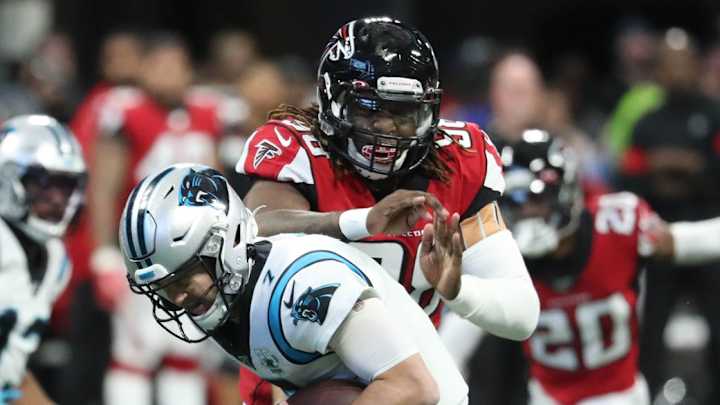Why the Browns Wanted Takkarist McKinley So Much

The Cleveland Browns finally got Takkarist McKinley after trying to claim him from waivers three times as well as discussing a trade for him with the Atlanta Falcons before he was waived. To understand why the Browns opted for McKinley over his former Falcons teammate Adrian Clayborn, who was released over a week ago comes down to one main factor; speed.
Clayborn came to the Browns as one of the best pass rushers in terms of defeating blocks. And at 280 pounds, offered some size for the position. He could only really line up on the right side due to being born with one arm being shorter than the other, but he could rush from the inside as well as the outside.
Clayborn was effective in his season with the Browns when he was healthy. Unfortunately, he suffered a hip strain that lasted from week two until the bye week. He was able to generate pressure and get a few sacks for the Browns. But in a division and a conference with so many athletic quarterbacks, Clayborn's inability to run could allow them to make plays with their legs.
Enter Takkarist McKinley, who is a sprinter off the edge with experience working from both sides. He's also not afraid to take on contact, which is critical. So when he's unblocked, McKinley can chase quarterbacks and close on them running away from him. McKinley also isn't afraid to try to collapse the pocket, simply shrinking the space a quarterback has to operate, creating opportunities for teammates.
The Browns are set to face Joe Burrow and Lamar Jackson twice per season within the division, but some of the main threats from the rest of the conference have quarterbacks like Patrick Mahomes, Josh Allen, Carson Wentz and potentially Justin Herbert, all strong and mobile.
One of the problems teams are facing is when a team like the Bills or Chiefs aren't even pretending they are running the ball, defenses don't have enough speed to put pressure on them as they run around and can find an open option or pull it down and run with it.
With McKinley, if the Browns are facing obvious passing situations, they can put McKinley in a wide-9 technique, coming out of sprinter's stance and just let him hunt after the quarterback like a rabid dog.
This causes a handful of problems for the offense. First, assuming the tackle doesn't have help because Myles Garrett is where any help would be, the tackle is immediately concerned about the threat of McKinley just running by them. If the tackle is oversetting to the outside to cut off the speed rush, McKinley can potentially convert speed to power and drive the tackle into the quarterback's lap.
It makes it more difficult for the quarterback to roll out to the side of McKinley, which also makes him slightly more predictable, which is good for the defense, particularly the defensive backs.
One notable example is Josh Allen, who is at his most dangerous going to his right, to his throwing hand. So it would be wise for a defense to try to make that as difficult as possible. McKinley potentially lined up on offense's right, he can sprint up field and at least complicate the issue.
Additionally, with a defense that is inclined to be smaller and faster with more safeties on the field, this could create blitzing lanes. In particular, if McKinley is sprinting up the field on the outside, it could open up a direct path to the quarterback through the B gap, which could lead to quick pressure and an opportunity to disrupt the play, potentially cause a sack or a turnover.
With more speed on the field, a false step, a slight misread from the blocking scheme or even a hesitation by the quarterback could lead to the arm being hit and a turnover. At the very least, the Browns are hoping it makes it so their defensive backs don't have to cover for quite as long.
Myles Garrett is already one of the most dangerous pass rushers in the league and the addition of McKinley has the potential to continue to speed up the quarterback's internal clock. So as good as Clayborn was, truly a worthwhile player on this defense, McKinley offers a dynamic that helps them deal with an AFC conference that is becoming more and more like college football. Spread out, featuring receiver talent that goes deeper and uses the quarterback's legs to keep defenses off balance.
